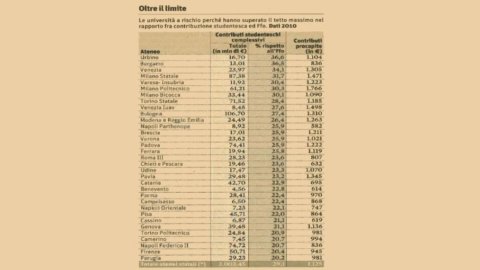Thirty three. It's not the Trentino people who enter Trento trotting, but it's the universities that exist in Italy by breaking the law. They are the 33 outlawed universities, unearthed by a search by Sun 24 Hours, because they ask their students too high fees, in contravention of the art. 5 of Presidential Decree 306/1997 which prevents public universities from collecting from student contributions a sum exceeding 20% of the check disbursed each year by the State in the form of financing.
Thirty-three universities means more than 55% of all public universities, a significant percentage, more than half, and whose problem is already known and repeatedly denounced by the press. However, the Government had always turned a deaf ear, but the Lombardy Tar has thought about stirring things up in recent days, which has condemned the University of Pavia to return the excess sum to the students.
And now, as often happens, there is the risk of a domino effect: the Order of students has won its first battle, which could only be the first of a long war, also because those directly involved throughout the Italian territory, that is, the students enrolled in the other 32 outlawed universities are a total of one million. The "bloodiest" battles are foreseen in Urbino, Venice and Bergamo, where a possible similar sentence from the respective Tars would cost the universities 15% of the sum paid by the students to be repaid.
The problem is twofold: the increase in the fixed costs of Italian faculties and above all the ongoing debate on public funding, which since 2009 due to the effects of the cuts has begun to decrease, remaining practically absorbed only by the salaries of teachers and staff.
And to lose who are they? The students. In 2010, the average student paid 1.125 euros for tuition, with a significant increase of almost 40% compared to the averages of 5 years earlier. But there are also sensational cases where the fee has practically doubled, such as in Siena and Lecce.
The real problem now is that the situation can only get worse: by increasingly decreasing public funding, i.e. the denominator on which to calculate the maximum percentage that can be asked of enrolled students, the number of non-standard universities will inexorably increase.
In short, many disputes are expected in the coming months, a lot of work for the Tar but above all, it would be desirable, a university reform that puts an end to the problem.





